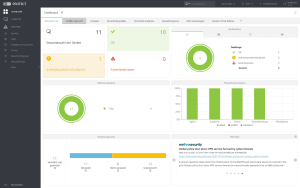
Double protection against blackmail Trojans at the same working speed. ESET integrates Intel technology for hardware-based ransomware detection in its enterprise endpoint products.
The IT security manufacturer ESET will raise its protection against blackmail Trojans to a new level. The "ransomware shield" already integrated in the security solutions is given a hardware-based counterpart to provide even better protection against the greatest threat on the Internet at the moment. To this end, ESET will integrate Intel Threat Detection Technology (Intel TDT) into its multi-layered cybersecurity technology suite. The benefits will be available in upcoming versions of ESET endpoint products throughout the year. Initially, ESET will focus on 9th Gen Intel Core devices and newer Windows PCs with Intel vPro. These are already able to use Intel TDT immediately after installation.
Double protection against ransomware with no speed limit

ESET integrates Intel technology for hardware-based ransomware detection in its endpoint products (Image: ESET).
For ESET and its customers, the cooperation brings a double benefit: On the one hand, Intel TDT Machine Learning promotes the detection of ransomware. As Intel TDT machine learning continues to evolve, the capability of ESET endpoint solutions will improve accordingly. In this way, unknown variants of blackmail malicious code can be detected and combated even more quickly.
On the other hand, the usual working speed remains optimal because the integrated Intel graphics unit (GPU) supports the search for ransomware. “Low impact on system performance is an area that ESET has always prioritized within its layered software architecture – and is a key selling point for many of our customers. Using technologies that help us prevent and protect while maintaining performance is a win-win decision,” said Előd Kironský, Chief of Endpoint Solutions and Security Technologies at ESET.
Hardware and software based detection
Leveraging CPU-level telemetry is a key development step to improve tracking of malicious encryption. ESET can detect ransomware as soon as it wants to hide in memory. The combination of the software-based, layered security approach and the addition of hardware-based detection could prove to be the next milestone in the fight against threats.
“Ransomware affects both small businesses and large corporations and can lead to economic impacts on a global scale. We are excited to partner with ESET, which offers a truly global deployment opportunity. ESET's ransomware optimizations will work with both Intel vPro Enterprise and our new Intel vPro Essentials for small and medium businesses. This offers a compelling hardware and software bundle that offers businesses of all sizes the right level of security and enables greater efficiency of ESET software on Intel-based PCs. This is a big step forward in winning the battle against ransomware,” said Carla Rodriguez, Sr Director Ecosystem Partner Enablement, Intel Corp.
More at ESET.com
About ESET ESET is a European company with headquarters in Bratislava (Slovakia). ESET has been developing award-winning security software since 1987 that has already helped over 100 million users enjoy secure technology. The broad portfolio of security products covers all common platforms and offers companies and consumers worldwide the perfect balance between performance and proactive protection. The company has a global sales network in over 180 countries and branches in Jena, San Diego, Singapore and Buenos Aires. For more information, visit www.eset.de or follow us on LinkedIn, Facebook and Twitter.
